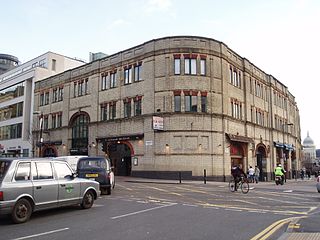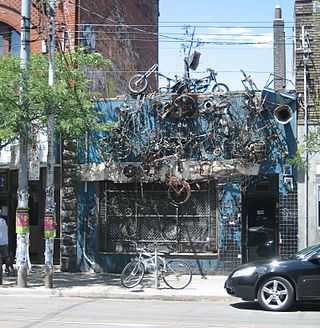Related Research Articles
House is a music genre characterized by a repetitive four-on-the-floor beat and a typical tempo of 120 beats per minute as a re-emergence of 1970's disco. It was created by DJs and music producers from Chicago's underground club culture and evolved slowly in the early/mid 1980s, and as DJs began altering disco songs to give them a more mechanical beat. By early 1988, House became mainstream and supplanted the typical 80s music beat.

A rave is a dance party at a warehouse, club, or other public or private venue, typically featuring performances by DJs playing electronic dance music. The style is most associated with the early 1990s dance music scene when DJs played at illegal events in musical styles dominated by electronic dance music from a wide range of sub-genres, including drum and bass, dubstep, trap, break, happy hardcore, trance, techno, hardcore, house, and alternative dance. Occasionally live musicians have been known to perform at raves, in addition to other types of performance artists such as go-go dancers and fire dancers. The music is amplified with a large, powerful sound reinforcement system, typically with large subwoofers to produce a deep bass sound. The music is often accompanied by laser light shows, projected coloured images, visual effects and fog machines.
Hip house, also known as rap house or house rap, is a musical genre that mixes elements of house music and hip hop music, that originated in both London, United Kingdom and Chicago, United States in the mid to late 1980s.

A free party is a party "free" from the restrictions of the legal club scene, similar to the free festival movement. It typically involves a sound system playing electronic dance music from late at night until the time when the organisers decide to go home. A free party can be composed of just one system or of many and if the party becomes a festival, it becomes a teknival. This typically means that drugs are readily available. The word free in this context is used both to describe the entry fee and the lack of restrictions and law enforcement.

299 Queen Street West, also known as Bell Media Queen Street or Bell Media Studios, is the headquarters of the television/radio broadcast hub of Bell Canada's media unit, Bell Media, and is located at the intersection of Queen Street West and John Street in Downtown Toronto, Ontario, Canada. The building previously served as the headquarters of CTVglobemedia until Bell Canada acquired CTV again in 2011 as well as CHUM Television, a division of CHUM Limited, until CTV acquired CHUM in 2007, and was once known as the CHUM-City Building. It is now head offices and downtown Toronto studios for Bell Media.

CIDC-FM is a radio station licensed to Orangeville, Ontario, Canada. Owned by Evanov Communications, the station broadcasts a rhythmic contemporary format targeting the Greater Toronto Area. Its studios are located on Dundas Street West in the Eatonville neighbourhood in the Etobicoke district of Toronto.

The Turnmills building was a warehouse originally on the corner of Turnmill Street and Clerkenwell Road in the London Borough of Islington. It became a bar in the 1980s, then a nightclub. The club closed in 2008 and the building was later demolished, replaced with an office building.
Stereo is a nightclub and afterhours club in Montreal, Quebec which primarily features house and techno music. The nightclub is known for its sound system and loyal following. Stereo has ranked among the top nightclubs in North America and internationally.

The Guvernment, formerly known as RPM, was a nightclub complex in Toronto, Ontario, Canada. It was also the name of one of the two main performance venues within the complex. The other venue was Kool Haus. Other smaller rooms within the complex included: The Drink, D'Luxe Lounge, The Orange Room, SkyBar, Charlies, Tanja and Acid Lounge. The Guvernment opened in 1996 and closed in early 2015.
The Warehouse is a historic building located in Chicago, Illinois in the United States, best known for the same-named nightclub catering to the gay and alternative communities that was established in 1977 under the direction of Robert "Robbie" Williams. It was Robbie Williams who on promotional posters would describe events at the Warehouse as 'house' parties or 'house' music. As such, the Warehouse is best known as the namesake for, and one of the origins of, house music. The Warehouse is specifically associated with Chicago house, and was the genre's birthplace under its first musical director, DJ Frankie Knuckles.

The Bovine Sex Club is a bar on Toronto's Queen Street West strip. In operation since January 1991, the Bovine Sex Club has at various times found itself at the forefront of Toronto's rock, punk, alternative, and rockabilly music scenes.
Nation was a live music/club venue, located at 1015 Half Street SE, in the Navy Yard/Near Southeast neighborhood, of Washington, D.C.

The Toronto Entertainment District is an area in downtown Toronto, Ontario, Canada. It is concentrated around King Street West between University Avenue and Spadina Avenue. It is home to theatres and performing arts centres, the Toronto Blue Jays, and an array of cultural and family attractions. The area was also home to most of the nightclubs in downtown Toronto. They have mostly moved to King St west of Spadina Av just beside the Entertainment District.
Buzz – once called "Washington's best electronic dance night" by The Washington Post - was one of Washington, D.C.'s longest running dance parties. It was co-founded by DJ/promoter Scott Henry and DJ/promoter and DC music store owner Lieven DeGeyndt at the East Side Club and then relaunched in October 1995 at the now demolished Nation, formerly the Capital Ballroom. At its peak it was one of the largest dance parties on the East Coast and voted "Best Party" four years in a row by then electronic dance music culture magazine URB (magazine). Buzz attracted the world's top electronic dance music artists to Washington, DC.

250 Richmond Street West is a studio complex in Downtown Toronto, Ontario, Canada. The building now serves as the headquarters of iHeartRadio Canada's national radio operations of Bell Media, and as the studios of the company's Toronto radio stations, CHUM-FM, CFRB and CKFM-FM.
Acid house is a subgenre of house music developed around the mid-1980s by DJs from Chicago. The style is defined primarily by the squelching sounds and basslines of the Roland TB-303 electronic bass synthesizer-sequencer, an innovation attributed to Chicago artists Phuture and Sleezy D circa 1986.
INK Entertainment is a hospitality and entertainment company headquartered in Toronto that maintains various properties, mostly nightclubs and restaurants, as well as a country club, two annual music festivals, two talent agencies, and a hotel currently under construction. Most of its properties are located in Toronto, with a few others in Montreal, Niagara Falls, the Miami area, and Las Vegas.
Bechara "Charles" Khabouth is a Lebanese Canadian nightclub owner, restaurateur, music promoter, and hotelier. Controlling several Toronto-based hospitality properties and venues, he's been dubbed the "King of Clubs" due to his influence on the city's nightlife. In addition to Toronto, he also has venues in Niagara Falls, Montreal, and Miami Beach.
Babalu Club was one of the most well-known nightclubs of the early German techno scene and was located in Munich's Schwabing district from 1990 to 1994.
References
- 1 2 "23 Hop | Rave, Warehouse and Afterhours Venue" . Retrieved 2021-02-12.
- 1 2 "The Legend of 23 Hop: A Documentary on the Murky Origins of Toronto's Rave Scene". 2019-08-31. Retrieved 2021-02-12.
- 1 2 "Then & Now: 23 Hop". Then and Now: Toronto Nightlife History. 2014-09-17. Retrieved 2021-02-12.